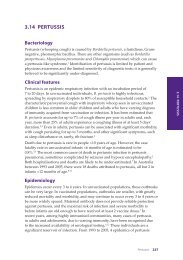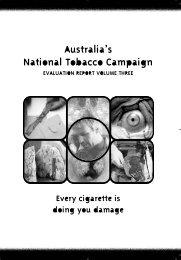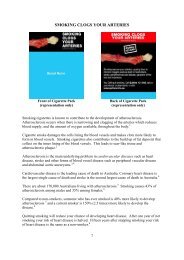Review of the management of adverse effects associated with ...
Review of the management of adverse effects associated with ...
Review of the management of adverse effects associated with ...
You also want an ePaper? Increase the reach of your titles
YUMPU automatically turns print PDFs into web optimized ePapers that Google loves.
The <strong>Review</strong> has found that <strong>the</strong> Australian system<br />
has a number <strong>of</strong> strengths. It is similar to passive<br />
<strong>adverse</strong> event surveillance systems in comparable<br />
countries and was able to detect <strong>the</strong> safety signal<br />
<strong>associated</strong> <strong>with</strong> <strong>the</strong> use <strong>of</strong> <strong>the</strong> 2010 seasonal<br />
influenza vaccine, take appropriate action and<br />
undertake a rigorous investigation.<br />
The <strong>Review</strong> has found that <strong>the</strong> reporting <strong>of</strong><br />
<strong>adverse</strong> events following immunisation could be<br />
more timely. Factors that impact on <strong>the</strong> timeliness<br />
<strong>of</strong> reporting include: health pr<strong>of</strong>essional and<br />
consumer knowledge <strong>of</strong> how to report; delays in<br />
information exchange between <strong>the</strong> jurisdictions<br />
and <strong>the</strong> TGA; reports being sent in batches;<br />
differing forms and protocols used in each<br />
jurisdiction; and a lack <strong>of</strong> agreed case definitions.<br />
The <strong>Review</strong> considers that, once <strong>the</strong> first batch<br />
<strong>of</strong> case reports had been received by <strong>the</strong> TGA,<br />
its actions in starting a thorough investigation<br />
were appropriate and timely. The decision <strong>of</strong> <strong>the</strong><br />
CMO to suspend <strong>the</strong> use <strong>of</strong> all seasonal influenza<br />
vaccines in young children was also appropriate,<br />
timely and proportionate. The subsequent<br />
investigation was extensive and thorough.<br />
Updates were provided by <strong>the</strong> CMO to keep<br />
jurisdictions, health pr<strong>of</strong>essionals, consumers<br />
and <strong>the</strong> media informed <strong>of</strong> <strong>the</strong> findings <strong>of</strong> <strong>the</strong><br />
investigation as <strong>the</strong>y became available.<br />
The <strong>Review</strong> has found that knowledge and<br />
awareness <strong>of</strong> <strong>the</strong> vaccine surveillance system and<br />
its processes and procedures among jurisdictions,<br />
health pr<strong>of</strong>essionals and consumers could be<br />
improved.<br />
Some health pr<strong>of</strong>essionals and consumers<br />
felt <strong>the</strong>y were not sufficiently informed <strong>of</strong> <strong>the</strong><br />
unfolding events surrounding <strong>the</strong> suspension <strong>of</strong><br />
<strong>the</strong> use <strong>of</strong> seasonal influenza vaccines and <strong>the</strong><br />
subsequent investigation, particularly in <strong>the</strong> early<br />
stages before <strong>the</strong> suspension was announced.<br />
The <strong>Review</strong> notes <strong>the</strong>re are significant challenges<br />
in determining how to communicate <strong>with</strong> health<br />
pr<strong>of</strong>essionals and <strong>the</strong> community during <strong>the</strong> early<br />
stages <strong>of</strong> an investigation, when <strong>the</strong>re is a level <strong>of</strong><br />
doubt about <strong>the</strong> significance <strong>of</strong> <strong>the</strong> events.<br />
There is a perception amongst some stakeholders<br />
that <strong>the</strong>re is a lack <strong>of</strong> transparency in <strong>the</strong><br />
TGA vaccine surveillance processes and that<br />
information about investigations into <strong>adverse</strong><br />
events <strong>associated</strong> <strong>with</strong> vaccines is slow to be<br />
made public.<br />
The <strong>Review</strong> has found that <strong>the</strong> Governance<br />
arrangements for vaccine safety issues<br />
are complex. While <strong>the</strong> TGA has legislated<br />
responsibility to monitor <strong>the</strong> safety <strong>of</strong> vaccines,<br />
many organisations, committees and individuals<br />
have a role, and <strong>the</strong>re is a lack <strong>of</strong> clarity <strong>of</strong> <strong>the</strong><br />
relationships between <strong>the</strong>se groups and <strong>the</strong>ir<br />
roles and responsibilities in vaccine safety<br />
monitoring and responding to <strong>the</strong> identification<br />
<strong>of</strong> a possible signal. The <strong>Review</strong> notes that<br />
<strong>the</strong>re are no Standard Operating Procedures for<br />
responding to a vaccine safety issue that does<br />
not require regulatory action but which has<br />
possible implications for <strong>the</strong> use <strong>of</strong> a vaccine in a<br />
vaccination program.<br />
x<br />
<strong>Review</strong> <strong>of</strong> <strong>the</strong> <strong>management</strong> <strong>of</strong> <strong>adverse</strong> events <strong>associated</strong> <strong>with</strong> Panvax and Fluvax







